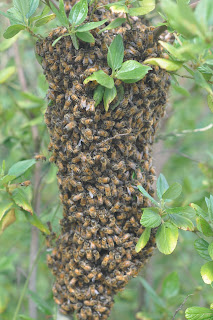As with just about every type of critter one can keep, the critters themselves end up being the least of your expenses. There's also the hive boxes- eight frame vs. ten frame, deciding what type of frame you want to use in those boxes, lids, inner covers, entrance reducers, hive stands, and hive bottoms. Then there's the beekeeper tools- most importantly- what type of protective clothing you're going to wear, and the smoker you'll use. Then there's the hive tool, bee brush, feeders, capping scrapers, and a few other things you may or may not eventually need. The bee keeper I got my frames of bees from recommended, after a long day of working his hives, that I get eight frame boxes as full boxes of bees and honey can get quite heavy.
While putting the frames of bees into the hives, we noticed several queen cups in the first hive, which the bee keeper scraped off of the frames. We didn't see either of the queens, but we did see several drones, which are bigger than the workers and look somewhat husky. Drones are the only male bees in the hive, and they serve just one purpose- to go out and mate with virgin queens. They can't even feed themselves, and have to beg the workers to feed them, and once they mate with a queen, they die.
Drone hanging out on the hive porch
I went back a week later and found that queen cups (where the hive grows new queens) had shown up again in the hive that had contained them the previous week. Before scraping the queen cups off this time, I decided to look and see if I could find the queen. I was unable to find her, so I left the queen cups alone, and checked the other hive, in which I did find the queen. Two weeks later, the cups had hatched out, and a new queen had established herself.
In the month after getting the original two hives, we captured three swarms that showed up at our farm. Luckily, all of the swarms decided to beard on low hanging branches of plants, so they were relatively easy to capture.
A beard of bees
The first swarm was pretty large, and is now my strongest hive. The second two swarms were small, and when checking one of them, I found that they had no queen, so I combined the two. We now have four hives in our "bee garden".
We selected a location where the bees would have morning sun and afternoon shade, and where they would be out of the way of farm visitors. I'm glad we started with two hives as the hive that hatched out a new queen has never really recovered and is currently my weakest hive, and should be requeened in the spring- if I hadn't had another hive to compare with, I'd probably be pretty discouraged with my first experience in beekeeping.
I love to take a few minutes to go sit near the hives and watch the workers flying in and out on their daily chores of gathering pollen and nectar. The guards check all who enter, while other workers either fan at the entrance to help with ventilation and temperature control, or scurry about filling in cracks and crannies with propolis. The workers typically pay me no heed even though I sit within a few feet of their homes, going about their daily chores since I am not threatening their hives in any way. There's a faint scent of honey in the air and a contented buzzing which has made this one of my favorite spots on the farm.




No comments:
Post a Comment